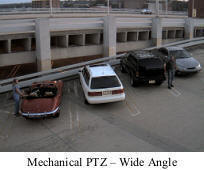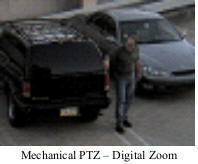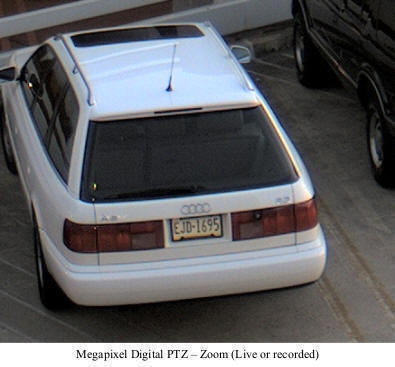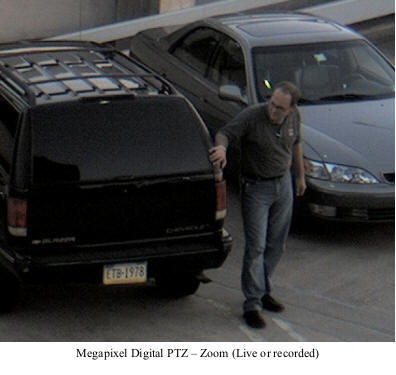November 2007
![]()
AutomatedBuildings.com
[an error occurred while processing this directive]
(Click Message to Learn More)
November 2007 |
[an error occurred while processing this directive] |
|
Part 3: To Digital Zoom or Not To Digital Zoom: Digital PTZ vs. Mechanical PTZ |
|
We arrive at Part 3 of our 3-part series megapixel technology. In Part I we took a look at the overall cost of megapixel video based on the three types of surveillance, General Surveillance, Forensic and High Detail and their comparative costs on a pixel/foot basis. In Part 2, we looked at an apples-to-apples comparison of deploying a megapixel video system instead of a low resolution (4CIF) system and how in many applications, megapixel is much more affordable.
|
|
|
|
|
|
|
|
|
|
|
|
|
|
|
|
|
|
|
|
|
[an error occurred while processing this directive] |
PTZ Pros and Cons
In Part III we will tackle the pros and cons of Pan/Tilt/Zoom (PTZPTZ)
systems vs. Mechanical PTZPTZ systems. First, a primer. Mechanical Pan/Tilt/Zoom
cameras consist of motors, slip rings, gears and/or belts and wheels.
Traditionally, they were controlled by proprietary keyboards but recently, they
can be controlled by software. These devices are available as integrated units,
most commonly domes, or you can purchase the camera separately and mount it on a
Pan/Tilt motor. The amount of zoom, e.g.. 25X, depends on the ratio of the
telephoto setting to the wide angle setting. So, a lens that goes from 4mm to
100mm will have a 25x zoom. A lens that goes from 50mm to 150mm will only
provide 3X zoom but will be much better at zooming in farther away because of
the 150mm telephoto setting, however this won’t have as wide angle a setting
(50mm) as the 25X lens (4mm). All clear now?
Mechanical PTZ
Today, most mechanical PTZ cameras employ low resolution cameras, typically
around 704 x 480 or 1/3 of a megapixel. In order to get high-detail (80
pixels/foot) with that camera, you would need to zoom into an area that is no
wider than 8 feet (2.4M). If you zoomed out all the way you would now be
spreading those pixels out over a very very wide area and would lose all detail.
If your goal is to give security staff the ability to monitor general activity then zoom in over a long distance with good detail, then mechanical PTZ cameras with high zoom telephoto lenses are the way to go but there are a few things you should consider.
First, mechanical PTZ cameras should be thought of as “either/or”. You either get wide area coverage with low resolution or you get high resolution in a very narrow area. You cannot get both. This means if you are “zoomed in,” you will miss everything else. Alternatively if you are “zoomed out,” you won’t have any detail. If you are recording “zoomed out” mechanical PTZ images you can always “digitally zoom” after the fact, but the results aren’t pretty. This limitation places a great deal of responsibility on the guard controlling the camera, especially if there are simultaneous incidents in which case the guard must decide which is more important..
[an error occurred while processing this directive] The second thing to consider is the cost of 24/7 guards dedicated to controlling the cameras—a substantial amount of money. Next, if you are controlling the cameras over a TCP/IP network, there is often a long delay between when you tell a camera to PTZ and when it actually responds. Finally, mechanical PTZ cameras have lots of moving parts that wear and require periodic maintenance and repair.
Digital PTZ
The other approach many people are opting for is to use megapixel network
cameras with digital pan/tilt/zoom, like the Iqeye cameras. Megapixel Network
cameras are ideal for applications where you don’t have the resources to have
24/7 live monitoring of the cameras and therefore, have to rely on the forensic
value of recorded video. When combined with the right lens, megapixel network
cameras ensure that you will always have enough detail to go back after the fact
and have forensic evidence like license plate numbers and facial detail to
determine what happened.
If you opt for the megapixel network camera approach, the only thing you have to do is make sure you have selected the proper resolution camera and lens to provide with you the desired detail (pixels/foot). Once configured, you can digitally pan/tilt/pan/tilt/zoom around live images without affecting what is recorded. In fact multiple people can connect to the same camera at the same time and independently pan/tilt/zoom around (to see a demonstration go to http://democam4.iqeye.com/). Regardless of where someone may be digitally pan/tilt/zooming, you can always go back to recorded video and look at other areas with no loss of detail. Additionally, since cameras like the IQeye have no moving parts, there are virtually no maintenance requirements.
Below are a number of actual images that illustrate the discussion here about the different PTZ technologies available Evaluate your situation and security and detail needs and choose what’s best for you. If you have 24/7 guards, the ability to “live” zoom on a small object very far away is critical and you don’t care about the quality and digital zoom of recorded images, a mechanical PTZ camera solution may may be the right choice for you.
If, on the other hand you can’t afford to miss a thing, fixed megapixel network cameras are the right choice for you.
 |
 |
 |
 |
 |
 |
 |
[an error occurred while processing this directive]
[Click Banner To Learn More]
[Home Page] [The Automator] [About] [Subscribe ] [Contact Us]